Active Alignment of Large-Aperture Space Telescopes for Optimal Ellipticity Performance
Abstract
1. Introduction
2. Ellipticity
3. Active Alignment for Optimal Ellipticity Performance
- (1)
- In the first part, we obtain the aberration field corresponding to the optimal ellipticity performance through optimization. The mean ellipticity value of 11*11 field points is taken as the objective function and the misalignments of each mirror are taken as the variable. Meanwhile, the relationships between the PSF ellipticity at arbitrary field position and the misalignment parameters are established based on Fourier optics and nodal aberration theory.
- (2)
- In the second part, SM and the FSM are selected as the adjustable degrees of freedom for the optimal correction of ellipticity, and the adjustment amount of SM and FSM is calculated (multi-field wavefront aberrations are needed in advance).
4. Simulations
4.1. Optical System Used for Demonstrating the Proposed Active Alignment Strategy
4.2. Comparison of Ellipticity Distribution between the State of “Optimal Wavefront Aberration” and “Optimal Ellipticity Performance” in the Presence of Surface Deformation
4.3. Comparison of Ellipticity Distribution between the State of “Optimal Wavefront Aberration” and “Optimal Ellipticity Performance” in the Presence of Surface Deformation and Mirror Misalignments
5. Results
- (1)
- The full-field distribution of defocus and astigmatism is the main factor affecting the full-field distribution of ellipticity, while the full-field distribution of coma has little influence on the full-field distribution of ellipticity.
- (2)
- At the same field point, different values of defocus and astigmatism can produce different values of ellipticity. On orbit, the full-field distribution of ellipticity can be corrected by adjusting the full-field distribution of defocus and astigmatism.
- (3)
- There exists an inherent relationship between the proportion of full-field distribution of defocus and astigmatism for the state of “optimal ellipticity performance”: if the value of defocused aberration at a certain field point is comparatively large, the value of astigmatism at the corresponding point is relatively small, and if the value of astigmatism at certain field point is large, the value of defocus at the corresponding field point is relatively small. However, there is no similar “relationship” when the correction goal is “optimal wavefront error”.
6. Conclusions
Author Contributions
Funding
Institutional Review Board Statement
Informed Consent Statement
Data Availability Statement
Acknowledgments
Conflicts of Interest
References
- Bartelmann, M.; Schneider, P. Weak gravitational lensing. Phys. Rep. 2001, 340, 291–472. [Google Scholar] [CrossRef]
- The Shear Testing Programme—I. Weak lensing analysis of simulated ground-based observations. Mon. Not. R. Astron. Soc. 2006, 368, 1323–1339. [Google Scholar] [CrossRef]
- Paulin-Henriksson, S.; Amara, A.; Voigt, L.; Refregier, A.; Bridle, S.L. Point spread function calibration requirements for dark energy from cosmic shear. Astron. Astrophys. 2008, 484, 67–77. [Google Scholar] [CrossRef]
- Zeng, F.; Zhang, X.; Zhang, J.; Shi, G.; Wu, H. Optics ellipticity performance of an unobscured off-axis space telescope. Opt. Express 2014, 22, 25277–25285. [Google Scholar] [CrossRef]
- Howard, J.M.; Angeli, G.Z.; Cullum, M.J.; Ha, K.Q.; Shiri, R.; Smith, J.S.; Mosier, G.; Muheim, D. Optical modeling activities for NASA’s James Webb Space Telescope (JWST): Part V. Operational alignment updates. In Modeling, Systems Engineering, and Project Management for Astronomy III; SPIE: Bellingham, WA, USA, 2008; pp. 295–304. [Google Scholar]
- Wilson, R.N.; Franza, F.; Noethe, L. Active optics. I. A system for optimizing the optical quality and reducing the costs of large telescopes. J. Mod. Opt. 1987, 34, 485–509. [Google Scholar] [CrossRef]
- Kim, E.D.; Choi, Y.W.; Kang, M.S.; Choi, S.C. Reverse-optimization Alignment Algorithm using Zernike Sensitivity. J. Opt. Soc. Korea 2005, 9, 68–73. [Google Scholar] [CrossRef]
- Liu, Z.; Qi, P.; Xu, Y.; Ma, H.; Ren, G. Misalignment calculation on off-axis telescope system via fully connected neural network. IEEE Photonics J. 2020, 12, 1–12. [Google Scholar] [CrossRef]
- Lundgren; Mark, A. Alignment of a three-mirror off-axis telescope by reverse optimization. Opt. Eng. 1991, 30, 307–311. [Google Scholar] [CrossRef]
- Dominguez, M.Z.; Kang, H.; Kim, S.; Berrier, J.; Kim, D.W. Multi-field merit-function-based regression method for Wide Field Infrared Survey Telescope grism system alignment. Appl. Opt. 2019, 58, 6802. [Google Scholar] [CrossRef]
- Kim, S.; Yang, H.S.; Lee, Y.W.; Kim, S.W. Merit function regression method for efficient alignment control of two-mirror optical systems. Opt. Express 2007, 15, 5059–5068. [Google Scholar] [CrossRef]
- Lee, H.; Dalton, G.; Tosh, I.; Kim, S. Computer-guided alignment I: Phase and amplitude modulation of alignment-influenced optical wavefront. Opt. Express 2007, 15, 3127–3139. [Google Scholar] [CrossRef] [PubMed]
- Lee, H.; Dalton, G.B.; Tosh, I.A.J.; Kim, S.W. Computer-guided alignment II:Optical system alignment using differential wavefront sampling. Opt. Express 2007, 15, 15424–15437. [Google Scholar] [CrossRef] [PubMed]
- Lee, H.; Dalton, G.B.; Tosh, I.A.J.; Kim, S.W. Computer-guided alignment III: Description of inter-element alignment effect in circular-pupil optical systems. Opt. Express 2008, 16, 10992. [Google Scholar] [CrossRef]
- Guohao, J.U.; Ma, H.; Xu, B.; Wang, S.; Xu, S. Active alignment of space astronomical telescopes by matching arbitrary multi-field stellar image features. Opt. Express 2021, 29, 24446–24465. [Google Scholar]
- Zhengyang, L.B.Y.X.L. Active Alignment Method of Telescope Based on Star Ellipticity of MultiFieldofView. Acta Photonica Sin. 2021, 50, 0412002. [Google Scholar]
- Wu, W.; Luo, Z.; Yang, H.; Cao, Y.; Shang, J. Misalignments calculation method for optical systems based on the ellipticity distribution of stellar image. Infrared Laser Eng. 2022, 51, 20210391. [Google Scholar]
- Thompson, K.P. Aberration Fields in Tilted and Decentered Optical Systems; The University of Arizona: Tucson, AZ, USA, 1980. [Google Scholar]
- Thompson, K.P. Description of the third-order optical aberrations of near-circular pupil optical systems without symmetry. J. Opt. Soc. Am. A Opt. Image Sci. Vis. 2005, 22, 1389–1401. [Google Scholar] [CrossRef]
- Thompson, K.P. Multinodal fifth-order optical aberrations of optical systems without rotational symmetry: Spherical aberration. J. Opt. Soc. Am. A Opt. Image Sci. Vis. 2009, 26, 1090–1100. [Google Scholar] [CrossRef]
- Thompson, K.P. Multinodal fifth-order optical aberrations of optical systems without rotational symmetry: The comatic aberrations. J. Opt. Soc. Am. A 2010, 27, 1490–1504. [Google Scholar] [CrossRef]
- Thompson, K.P. Multinodal fifth-order optical aberrations of optical systems without rotational symmetry: The astigmatic aberrations. J. Opt. Soc. America. A Opt. Image Sci. Vis. 2011, 28, 821–836. [Google Scholar] [CrossRef]
- Schmid, T. Misalignment Induced Nodal Aberration Fields and Their Use in Thealignment of Astronomical Telescopes. Ph.D. Thesis, University of Central Florida, Orlando, FL, USA, 2010. [Google Scholar]
- Gu, Z.; Yan, C.; Wang, Y. Alignment of a three-mirror anastigmatic telescope using nodal aberration theory. Opt. Express 2015, 23, 25182. [Google Scholar] [CrossRef]
- Ju, G.; Yan, C.; Gu, Z.; Ma, H. Aberration fields of off-axis two-mirror astronomical telescopes induced by lateral misalignments. Opt. Express 2016, 24, 24665–24703. [Google Scholar] [CrossRef] [PubMed]
- Ju, G.; Ma, H.; Yan, C. Aberration fields of off-axis astronomical telescopes induced by rotational misalignments. Opt. Express 2018, 26, 24816. [Google Scholar] [CrossRef] [PubMed]
- Guohao, J.; Changxiang, Y.; Zhiyuan, G.; Hongcai, M. Nonrotationally symmetric aberrations of off-axis two-mirror astronomical telescopes induced by axial misalignments. Appl. Opt. 2018, 57, 1399. [Google Scholar]
- Xiaobin, Z.; Dong, Z.; Shuyan, X.; Hongcai, M. Active optical alignment of off-axis telescopes based on nodal aberration theory. Opt. Express 2016, 24, 26392. [Google Scholar]
- Zhang, X.; Xu, S.; Ma, H.; Liu, N. Optical compensation for the perturbed three mirror anastigmatic telescope based on nodal aberration theory. Opt. Express 2017, 25, 12867–12883. [Google Scholar] [CrossRef]
- Bai, X.; Ju, G.; Ma, H.; Xu, S. Aberrational interactions between axial and lateral misalignments in pupil-offset off-axis two-mirror astronomical telescopes. Appl. Opt. 2019, 58, 7693–7707. [Google Scholar] [CrossRef]
- Schiesser, E.M.; Bauer, A.; Rolland, J.P. Estimating field-dependent nodal aberration theory coefficients from Zernike full-field displays by utilizing eighth-order astigmatism. J. Opt. Soc. Am. A 2019, 36, 2115. [Google Scholar] [CrossRef]
- Bai, X.; Xu, B.; Ma, H.; Gao, Y.; Ju, G. Aberration fields of pupil-offset off-axis two-mirror astronomical telescopes induced by ROC error. Opt. Express 2020, 28, 30447. [Google Scholar] [CrossRef]
- Bai, X.; Xu, B.; Ju, G.; Ma, H.; Zhang, C.; Wang, S.; Xu, S. Aberration compensation strategy for the radius of curvature error of the primary mirror in off-axis three-mirror anastigmatic telescopes. Appl. Opt. 2021, 60, 6199–6212. [Google Scholar] [CrossRef]
- Karcı, Ö.; Arpa, E.; Ekinci, M.; Rolland, J.P. Experimental investigation of binodal astigmatism in nodal aberration theory (NAT) with a Cassegrain telescope system. Opt. Express 2021, 29, 19427–19440. [Google Scholar] [CrossRef] [PubMed]
- Karcı, Ö.; Yeiltepe, M.; Arpa, E.; Wu, Y.; Ekinci, M.; Rolland, J.P. Experimental investigation in nodal aberration theory (NAT): Separation of astigmatic figure error from misalignments in a Cassegrain telescope. Opt. Express 2022, 30, 11150–11164. [Google Scholar] [CrossRef] [PubMed]
- Zhao, N.; Papa, J.C.; Fuerschbach, K.; Qiao, Y.; Rolland, J.P. Experimental investigation in nodal aberration theory (NAT) with a customized Ritchey-Chrétien system: Third-order coma. Opt. Express 2018, 26, 8729–8743. [Google Scholar] [CrossRef] [PubMed]
- He, X.; Luo, J.; Wang, J.; Zhang, X.; Liu, Y. Improvement of a computer-aided alignment algorithm for the nonsymmetric off-axis reflective telescope. Appl. Opt. 2021, 60, 2127–2140. [Google Scholar] [CrossRef] [PubMed]
- Bernstein, G.M.; Jarvis, M. Shapes and Shears, Stars and Smears: Optimal Measurements for Weak Lensing. Astron. J. 2002, 123, 583–618. [Google Scholar] [CrossRef]
- Kuijken, K. Shears from shapelets. Astron. Astrophys. 2006, 456, 827–838. [Google Scholar] [CrossRef]
- Erben, T.; Van, W.L.; Bertin, E.; Mellier, Y.; Schneider, P. How accurately can we measure weak gravitational shear? Astron. Astrophys. 2000, 366, 717–735. [Google Scholar] [CrossRef]
- Laureijs, R.; Amiaux, J.; Arduini, S.; Auguères, J.-L.; Zucca, E. Euclid Definition Study Report; HAL-OBSPM: Paris, France, 2011. [Google Scholar]
- John, E.; Richard, N.; Felix, S.B. 20 years of Hubble Space Telescope optical modeling using Tiny Tim. Proc. SPIE-Int. Soc. Opt. Eng. 2012, 8127, 777–785. [Google Scholar]
- Krist, J.; Hook, R. The TinyTim User’s Guide; Baltimore Stsci: Baltimore, MD, USA, 2004. [Google Scholar]
- Xin, Q.; Guohao, J.; Shuyan, X. Efficient solution to the stagnation problem of the particle swarm optimization algorithm for phase diversity. Appl. Opt. 2018, 57, 2747–2757. [Google Scholar]
- Gong, Y.; Liu, X.; Cao, Y.; Chen, X.; Fan, Z.; Li, R.; Li, X.D.; Li, Z.; Zhang, X.; Zhan, H. Cosmology from the Chinese Space Station Optical Survey (CSS-OS). Astrophys. J. 2019, 883, 203. [Google Scholar] [CrossRef]
- Luo, J.; He, X.U.; Fan, K.; Zhang, X. Effects of polarization aberrations in an unobscured off-axis space telescope on its PSF ellipticity. Opt. Express 2020, 28, 37958–37970. [Google Scholar] [CrossRef] [PubMed]
- Wang, K.; Dong, J. Structural design of Φ2 m-level large-diameter SiC reflector used in space remote sensor. Infrared Laser Eng. 2017, 46, 718005. [Google Scholar] [CrossRef]
- Wang, K.; Dong, J.; Wang, X.; Chi, C. Design of frame-type support structure for space-based rectangular convex mirror tested on the back. Opt.-Int. J. Light Electron Opt. 2020, 212, 164673. [Google Scholar]
- Wang, K.; Dong, J.; Zhao, Y.; Chi, C.; Jiang, P.; Wang, X. Research on high performance support technology of space-based large aperture mirror. Opt. Z. Fur Licht-Und Elektron. J. Light-Electronoptic 2021, 226, 165929. [Google Scholar] [CrossRef]
- Zhang, X.; Hu, H.; Wang, X.; Luo, X.; Zhang, G.; Zhao, W.; Wang, X.; Liu, Z.; Xiong, L.; Qi, E. Challenges and strategies in high-accuracy manufacturing of the world’s largest SiC aspheric mirror. Light Sci. Appl. 2022, 11, 13. [Google Scholar] [CrossRef]


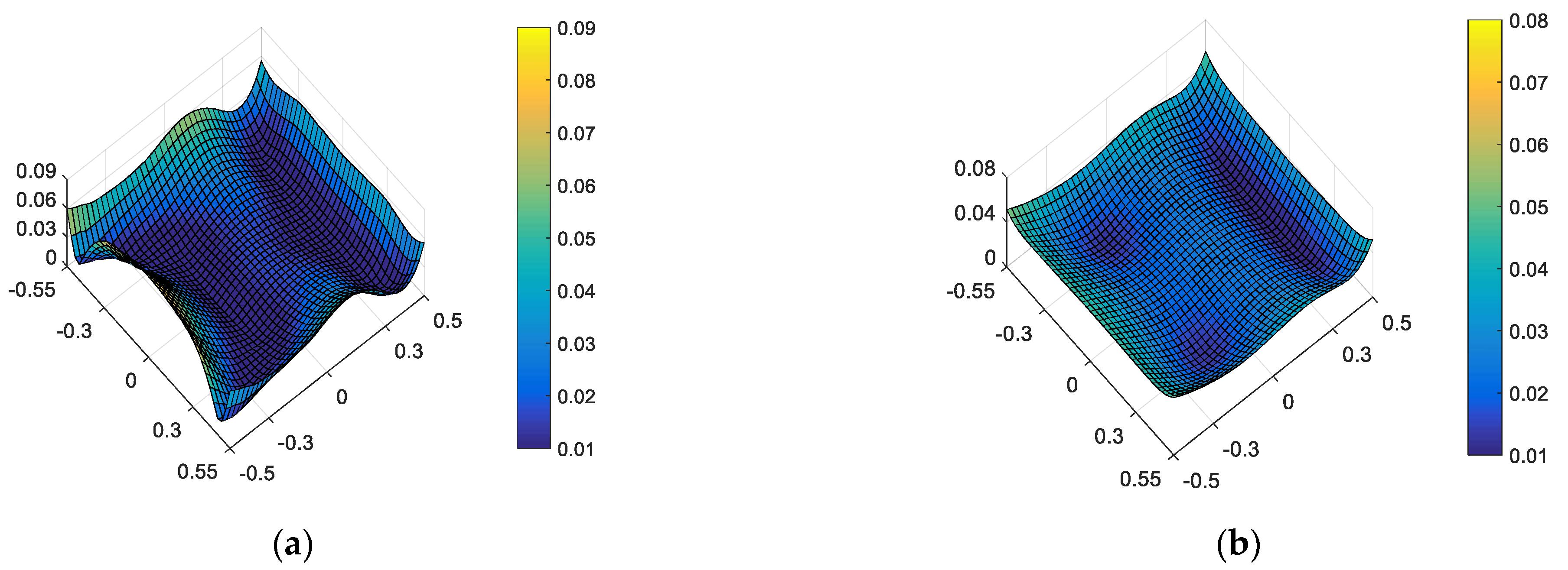


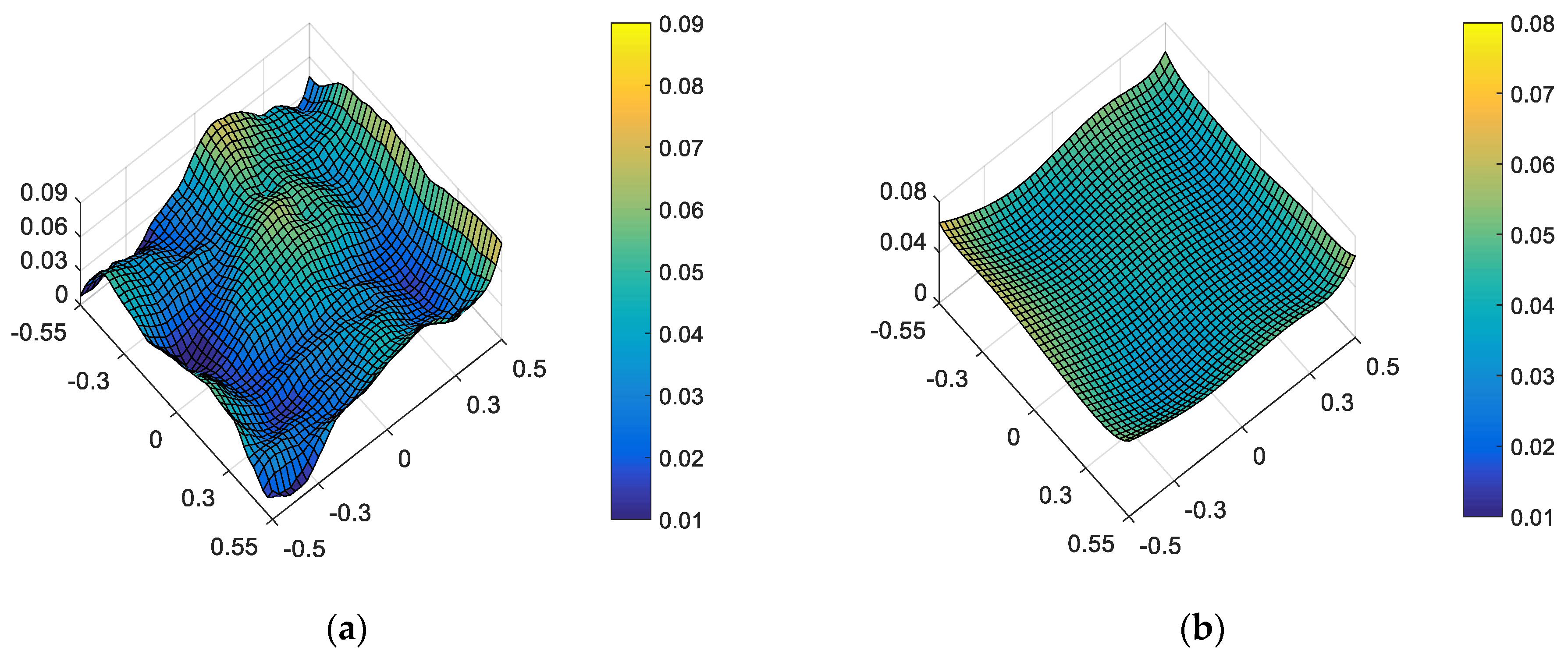
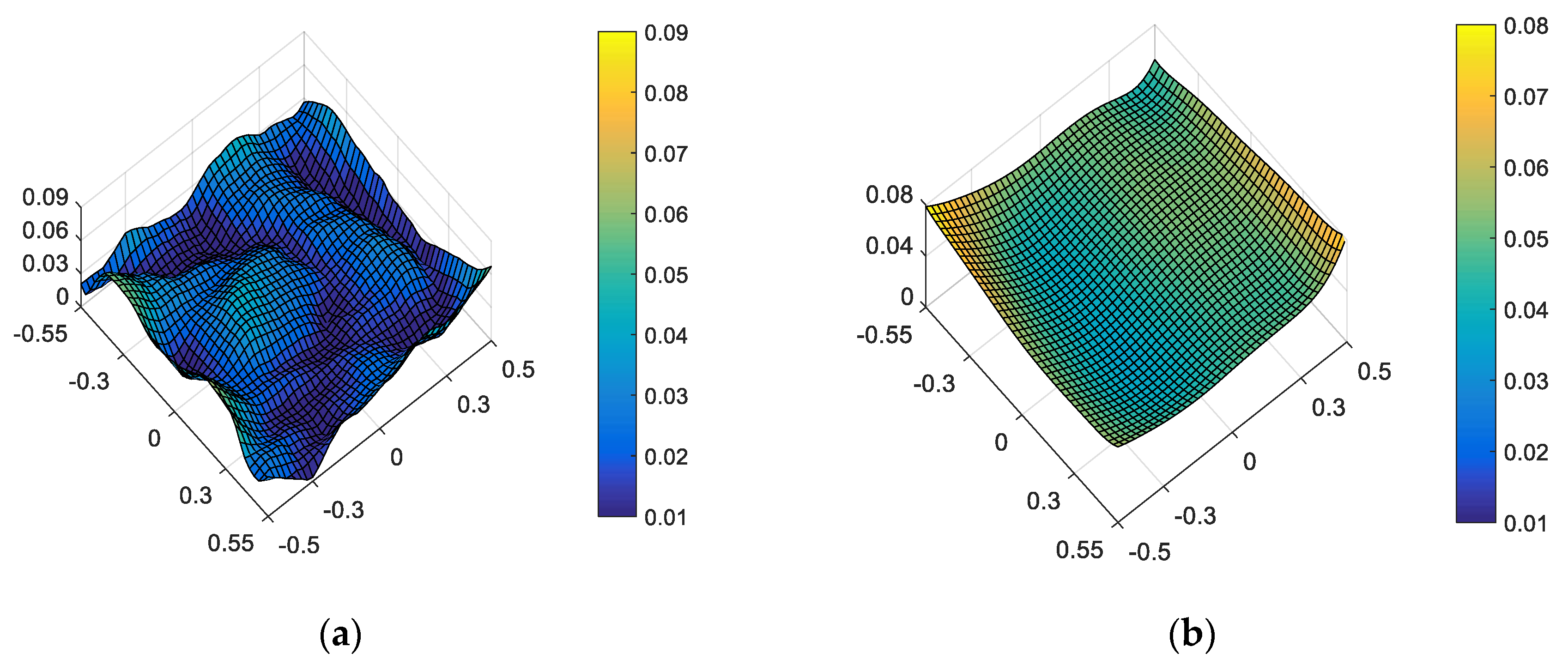
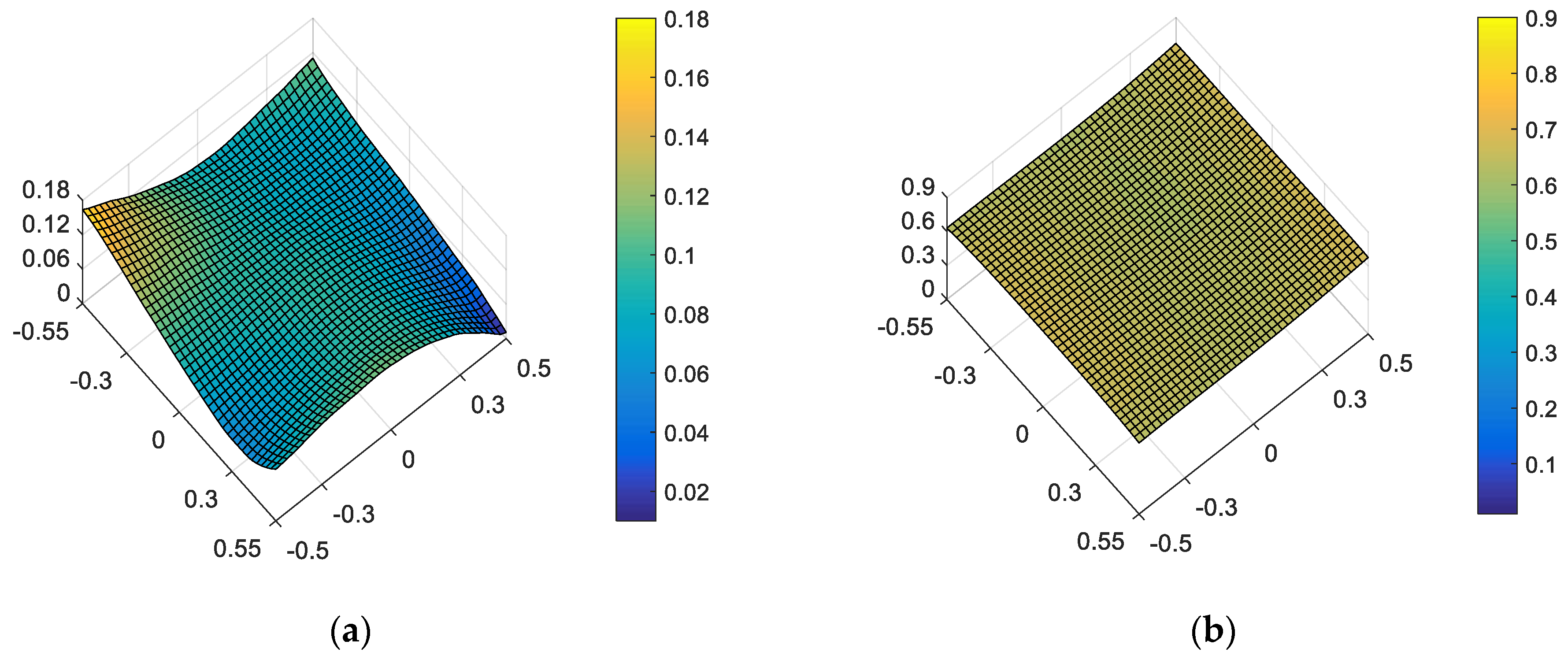
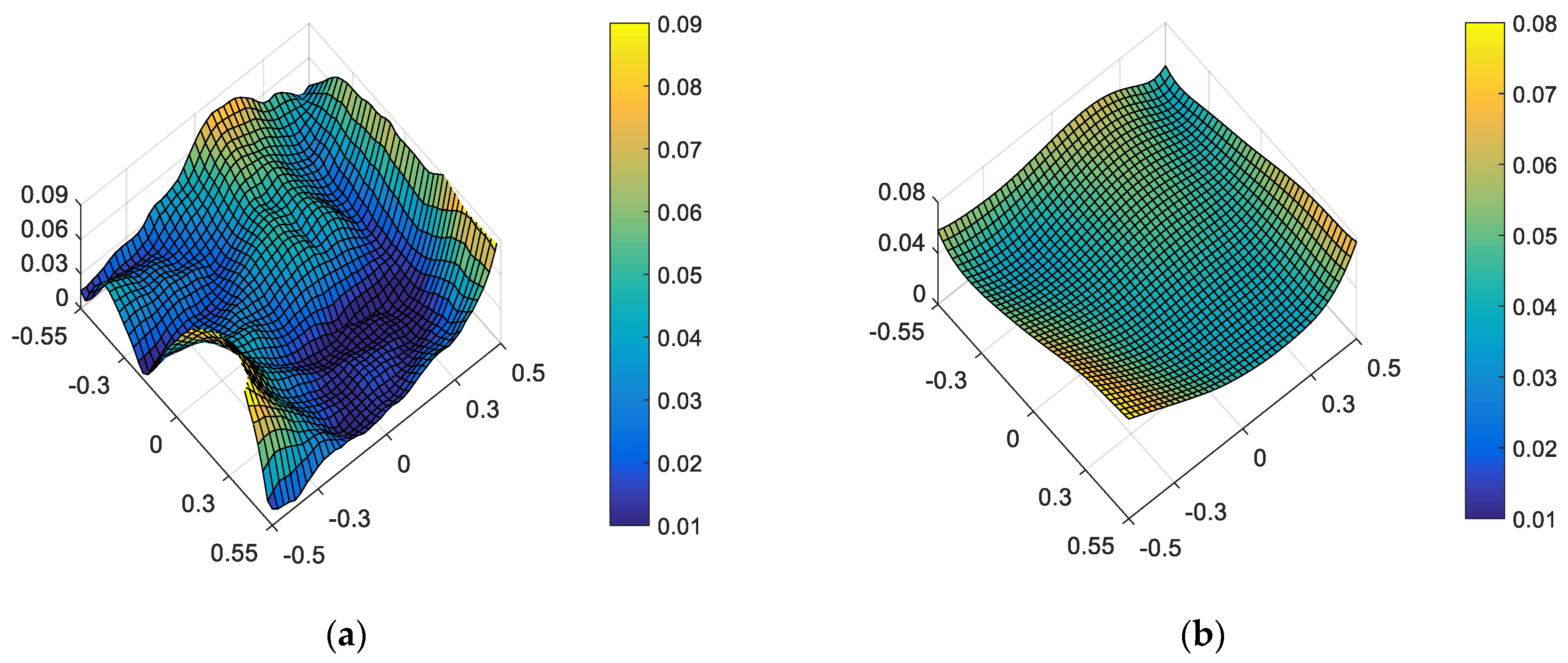
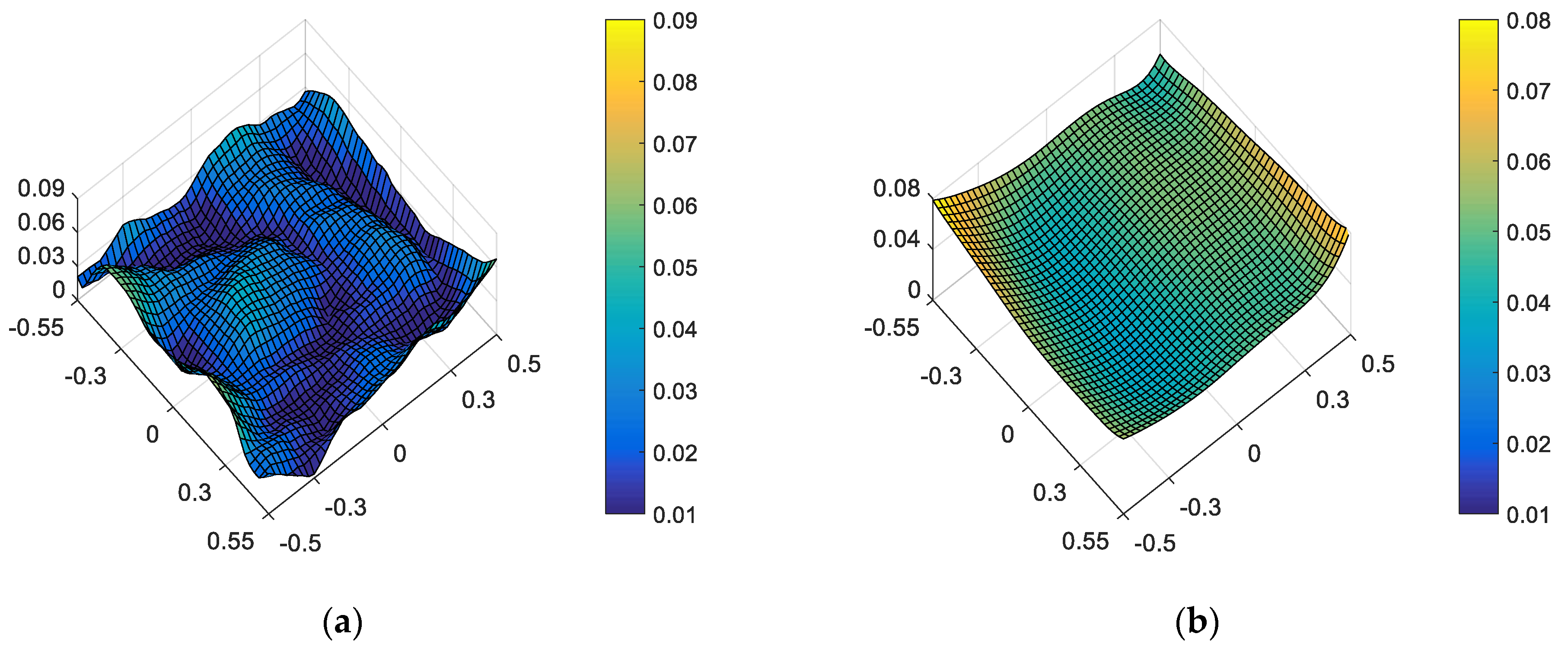
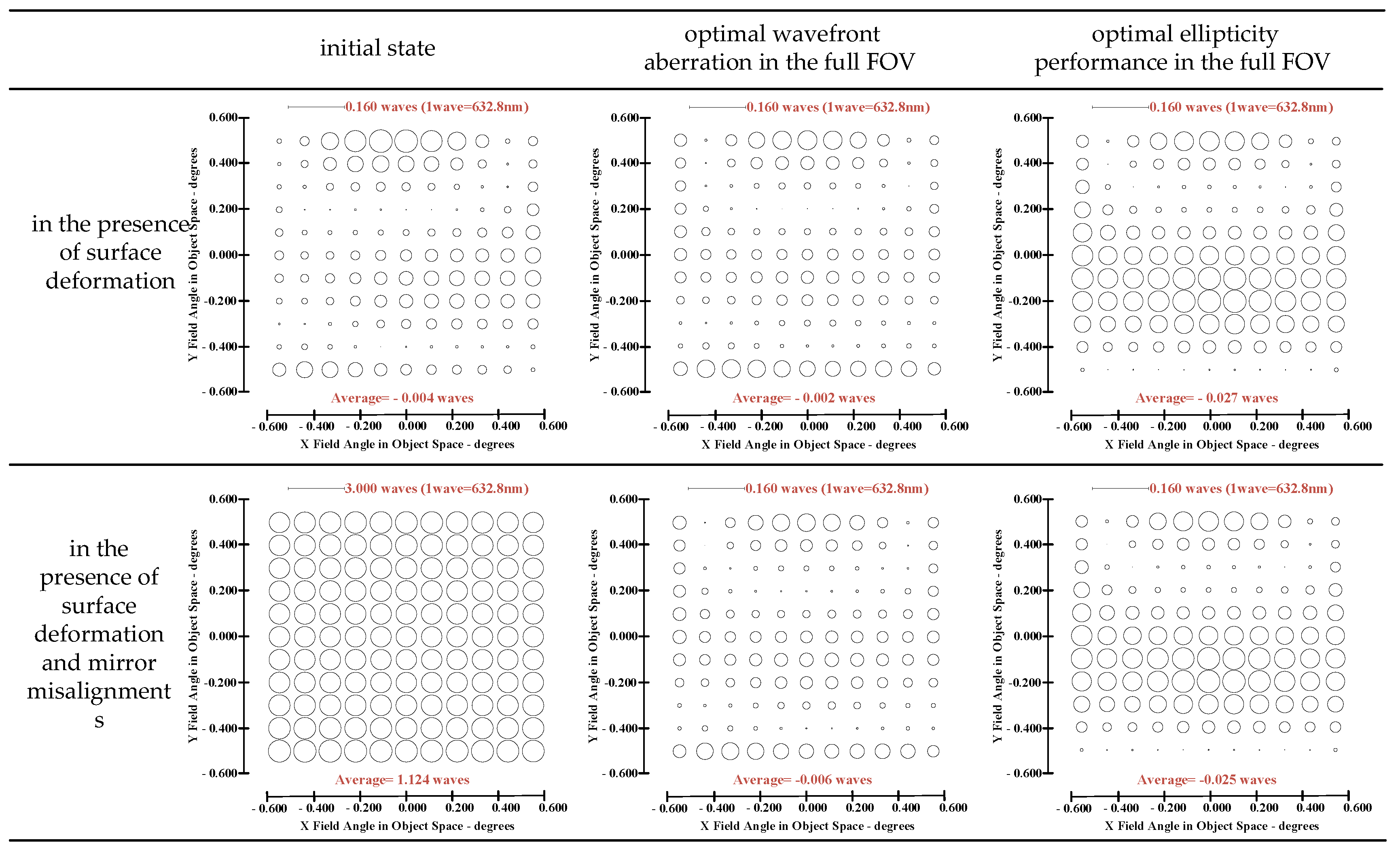
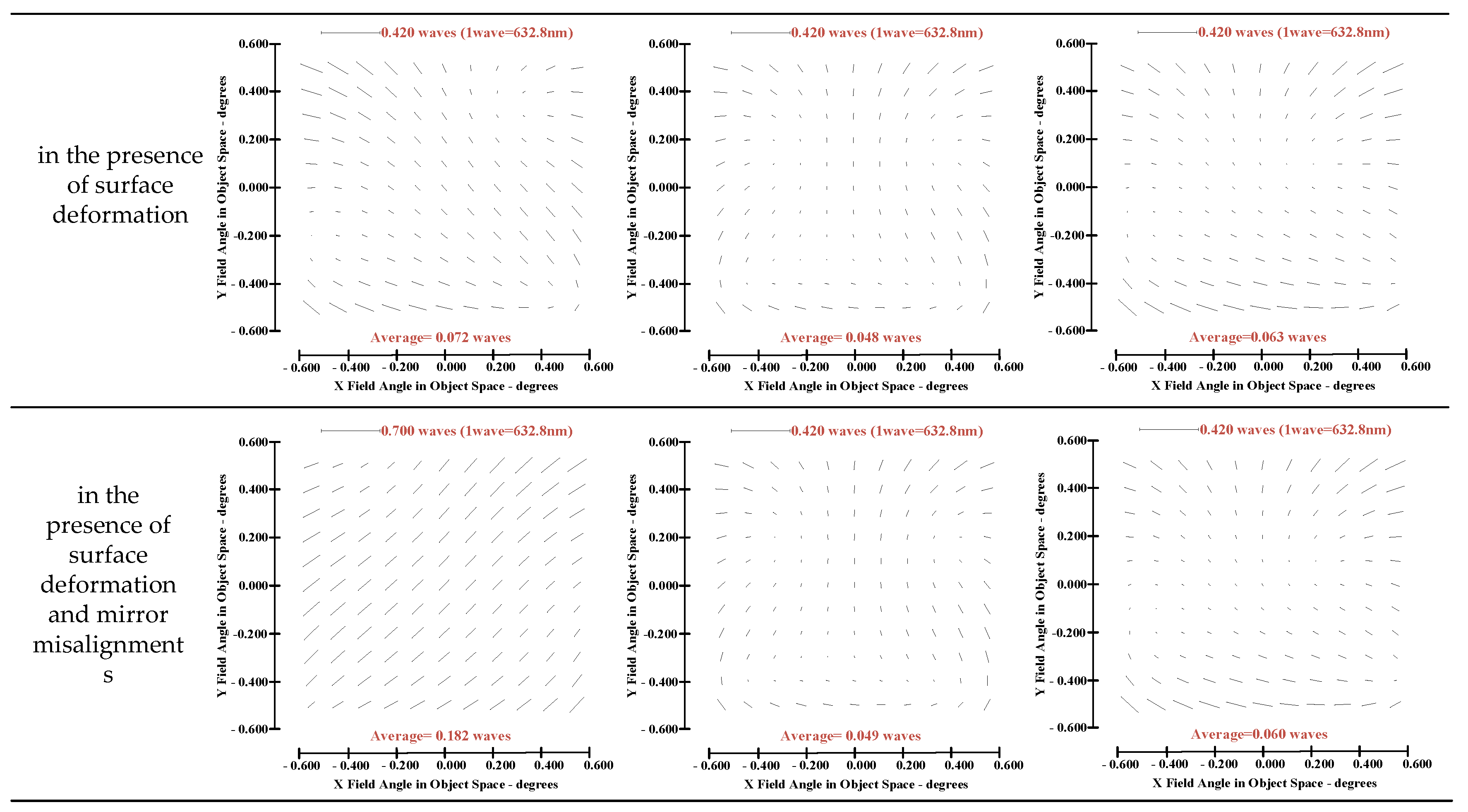
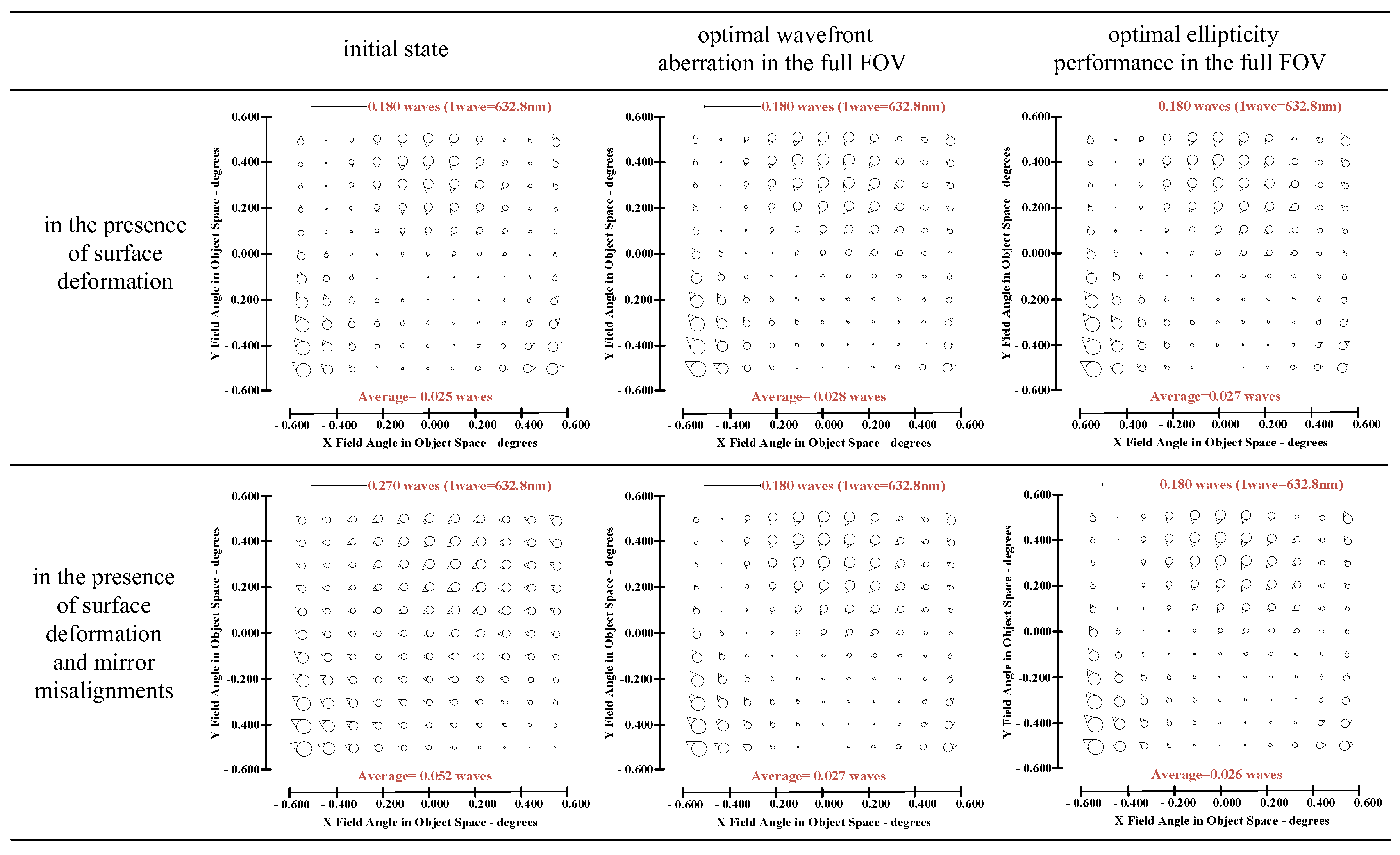
| Different State | Ellipticity | RMS WFE | ||
|---|---|---|---|---|
| Maximum Values | Mean Values | Maximum Values | Mean Values | |
| Nominal state | 0.0843 | 0.0234 | 0.0523λ | 0.0256λ |
| In the presence of surface deformations | 0.1152 | 0.0351 | 0.0778λ | 0.0472λ |
| “Optimal wavefront aberration” | 0.0857 | 0.0369 | 0.0647λ | 0.0426λ |
| “Optimal ellipticity performance” | 0.0670 | 0.0228 | 0.0825λ | 0.0492λ |
| Different State | Ellipticity | RMS WFE | ||
|---|---|---|---|---|
| Maximum Values | Mean Values | Maximum Values | Mean Values | |
| Nominal state | 0.0843 | 0.0234 | 0.0523λ | 0.0256λ |
| In the presence of complex working condition | 0.1641 | 0.0854 | 0.6881λ | 0.6448λ |
| “Optimal wavefront aberration” | 0.0810 | 0.0374 | 0.0633λ | 0.0430λ |
| “Optimal ellipticity performance” | 0.0664 | 0.0233 | 0.0807λ | 0.0486λ |
Disclaimer/Publisher’s Note: The statements, opinions and data contained in all publications are solely those of the individual author(s) and contributor(s) and not of MDPI and/or the editor(s). MDPI and/or the editor(s) disclaim responsibility for any injury to people or property resulting from any ideas, methods, instructions or products referred to in the content. |
© 2023 by the authors. Licensee MDPI, Basel, Switzerland. This article is an open access article distributed under the terms and conditions of the Creative Commons Attribution (CC BY) license (https://creativecommons.org/licenses/by/4.0/).
Share and Cite
Bai, X.; Gu, X.; Xu, B.; Jiang, F.; Lu, Z.; Xu, S.; Ju, G. Active Alignment of Large-Aperture Space Telescopes for Optimal Ellipticity Performance. Sensors 2023, 23, 4705. https://doi.org/10.3390/s23104705
Bai X, Gu X, Xu B, Jiang F, Lu Z, Xu S, Ju G. Active Alignment of Large-Aperture Space Telescopes for Optimal Ellipticity Performance. Sensors. 2023; 23(10):4705. https://doi.org/10.3390/s23104705
Chicago/Turabian StyleBai, Xiaoquan, Xixi Gu, Boqian Xu, Fengyi Jiang, Zhirong Lu, Shuyan Xu, and Guohao Ju. 2023. "Active Alignment of Large-Aperture Space Telescopes for Optimal Ellipticity Performance" Sensors 23, no. 10: 4705. https://doi.org/10.3390/s23104705
APA StyleBai, X., Gu, X., Xu, B., Jiang, F., Lu, Z., Xu, S., & Ju, G. (2023). Active Alignment of Large-Aperture Space Telescopes for Optimal Ellipticity Performance. Sensors, 23(10), 4705. https://doi.org/10.3390/s23104705




